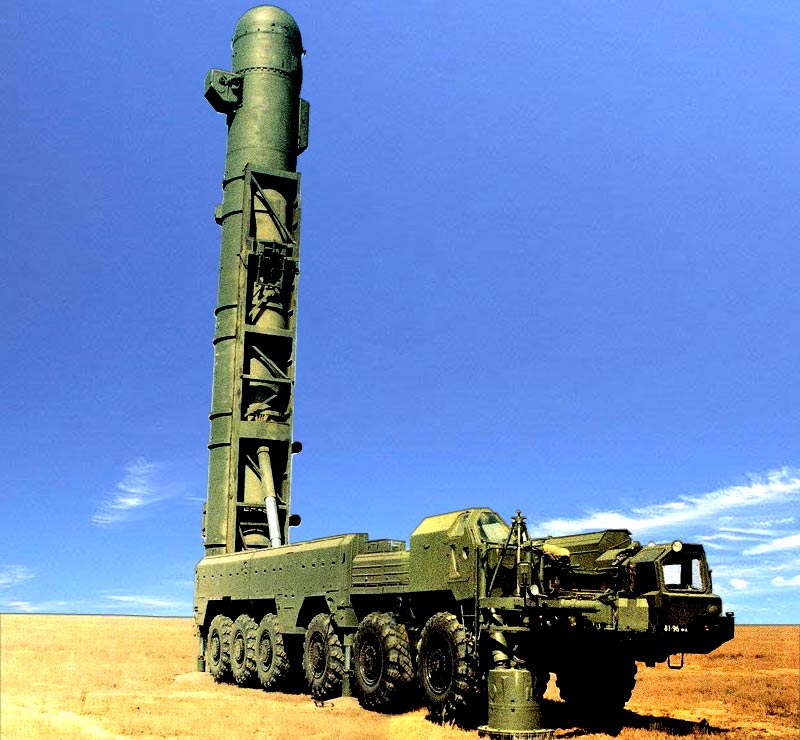The RSD-10 Pioneer (NATO: SS-20 “Saber”) was a Soviet intermediate-range ballistic missile (IRBM) that entered service in 1976. Its wide-scale deployment was a key driver behind NATO’s 1979 decision to station U.S. Pershing II IRBMs in Europe. The Soviet Union retired the SS-20 from service following the ratification of the Intermediate-Range Nuclear Forces (INF) Treaty in 1987.
Pioneer (SS-20 “Saber”) at a Glance
- Originated from
- Soviet Union
- Possessed by
- Soviet Union, Russia
- Alternate names
- Saber, Pioneer, RSD-10, 15Zh45/15Zh53
- Class
- Intermediate-range Ballistic Missile (IRBM)
- Basing
- Road-mobile
- Length
- 16.5 m
- Diameter
- 1.79 m
- Launch weight
- 37,000 kg
- Payload
- 3 x 150 kT warheads (Mod 2), 1 x 1 MT warhead (Mods 1 and 3)
- Warhead
- Nuclear, single warhead or MIRV
- Propulsion
- Two-stage solid propellant
- Range
- 5,000 km
- Status
- Obsolete
- In service
- 1976-1991
SS-20 Development
The SS-20 Saber was a two-stage solid-fueled missile developed by the Moscow Institute of Thermal Technology in the mid-1970s. The system was based on the first and second stages of the Temp-2S missile, a Soviet ICBM design developed around the same time. The SS-20 replaced the aging, liquid-fueled SS-4 and SS-5 missiles.1 The missiles were developed to be highly mobile and launched on short notice, which made it difficult for NATO forces to track them.
Specifications
The SS-20 was launched from a transporter erector launcher (TEL), which lent it the mobility to be easily forward deployed and launched from almost any road-accessible location.2 The SS-20’s range allowed it to reach most of Europe from Soviet territory.
The Soviet Union developed three different models of the SS-20 (Mod 1, 2, and 3). Mods 1 and 3 carried a single warhead of 1,000 kT. The Mod 2, the most widely deployed variant, was equipped with multiple independently targetable reentry vehicles (MIRV). A single Mod 2 could employ three 150 kT nuclear warheads.
The missile measured 16.5 m in length and 1.79 m in diameter, and had an estimated launch weight of 37,000 kg. It had a range of 5,000 km. This range allowed the SS-20 to target any location in Europe from Soviet territory, but was insufficient to reach the continental United States.3
Service History
The SS-20 entered service with the Soviet rocket forces in 1976. By 1987, the USSR had deployed 441 SS-20 missiles. These were housed in multiple locations in the Soviet Union, including west of the Ural mountain range and near Teykovo, about 193 km northeast of Moscow.4
In response to these deployments, NATO announced in 1979 that it would begin to station U.S. Pershing II IRBMs and ground-launched cruise missiles (GLCM) in Western Europe starting in 1983.5
In 1981, the United States offered to cancel the Pershing 2 and GLCM deployments in exchange for the dismantlement of the SS-20s and the final retirement of the SS-4 and SS-5 IRBMs.6 This proposal sparked talks that ultimately led to the Intermediate-Range Nuclear Forces (INF) Treaty in 1987. The INF Treaty eliminated all U.S. and Soviet ground-launched ballistic and cruise missiles with ranges between 500-5,500 km.7
In 1988, the Soviet Union began eliminating its stockpile of SS-20s.8 The missiles were first removed from their launchers, and placed in an outlying area at Kapustin Yar for destruction with high explosives. According to media reports at the time, the first group of SS-20s were “packed with nearly a ton of high explosives that, along with their own solid propellant fuel, ensured their total demolition.”9
The Soviets also disposed of SS-20s by launching them (without warheads) into space from bases in far eastern regions of the USSR.10 As many as 72 missiles were destroyed in this way.11 By 1991, all SS-20 missiles (509 launchers and 654 missiles) had been eliminated to comply with the INF Treaty.
Footnotes
- Henry H. Gaffney, “Euromissiles as the Ultimate Evolution of Theater Nuclear Forces in Europe,” Journal of Cold War Studies 16, no. 1 (Winter 2014): 180-99, doi:10.1162/jcws_a_00435.
- Oleg Bukharin and Frank Von Hippel, Russian Strategic Nuclear Forces, (Cambridge, MA: MIT, 2004), 224.
- John Pike et al., “RT-21M / SS-20 SABER,” RT-21M / SS-20 SABRE – Russian / Soviet Nuclear Forces, July 18, 2000, https://fas.org/nuke/guide/russia/theater/rt-21m.htm.
- Robert Hutchinson, Weapons of Mass Destruction: The No-Nonsense Guide to Nuclear, Chemical and Biological Weapons Today, Orion Publishing Group, 2011.
- NATO, “A Short History of NATO,” North Atlantic Treaty Organization, http://www.nato.int/cps/en/natohq/declassified_139339.htm?selectedLocale=en.
- “Ministerial Declaration on Intermediate-Range Nuclear Force Modernization and Arms Control,” North Atlantic Treaty Organization, December 11, 1981, http://www.nato.int/cps/en/natohq/official_texts_23108.htm?selectedLocale=en.
- Note: The treaty did not cover sea-launched missiles. U.S. State Department, “Intermediate-Range Nuclear Forces Treaty (INF Treaty),” U.S. Department of State, https://www.state.gov/t/avc/trty/102360.htm.
- “Soviets Destroy 3 SS-20s with Huge Explosion,” LA Times, August 29, 1988.
- Ibid.
- Ibid.
- Pavel Podvig, Russian Strategic Nuclear Forces, (Cambridge, MA: The MIT Press, 2001), 226.
